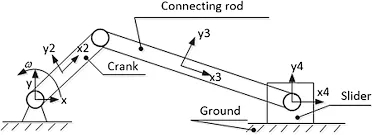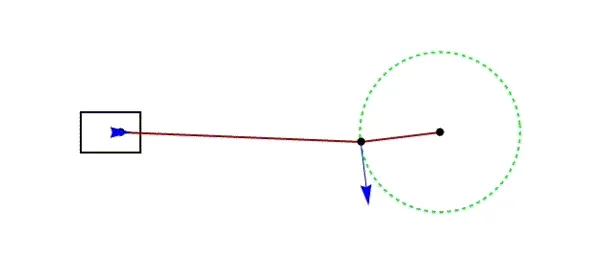🔑 Fundamental Stress Formula
Where:
- σ = Normal stress (Pa or N/m²)
- F = Applied force (N)
- A = Cross-sectional area (m²)
Physical Meaning: Force distributed over area - higher force or smaller area = higher stress
Learn fundamental mechanics of materials concepts by analyzing the connecting rod in a crank-slider mechanism, covering stress-strain relations, Young’s modulus, and Poisson’s ratio.
By the end of this unit, you will be able to:
Consider an internal combustion engine or reciprocating compressor. At the heart of these systems lies the crank-slider mechanism—one of the most fundamental motion conversion systems in mechanical engineering.

The crank-slider mechanism consists of:
tension and compression)Critical Question: During the compression stroke of an engine, enormous forces act on the connecting rod. How do we ensure this rod won’t fail under these extreme loads?
This is where mechanics of materials becomes essential. Without understanding stress and strain, we cannot:
Predict if the connecting rod will buckle or breakmaterials (steel, aluminum, titanium)Optimize the rod’s cross-sectional shapereliable operation over millions of cyclesModern engines and compressors are mechatronic systems integrating:
But if the connecting rod fails mechanically, no amount of sophisticated control can save the system.
Now that we understand why we need mechanics of materials, let’s develop the theoretical foundation to analyze our connecting rod.
Stress is the internal resistance of a material to applied forces, measured as force per unit area:
🔑 Fundamental Stress Formula
Where:
Physical Meaning: Force distributed over area - higher force or smaller area = higher stress
Normal Stress (σ):
Shear Stress (τ):
Common Stress Units:
Typical Values:
Strain is the measure of deformation—how much a material changes shape under stress:
📐 Fundamental Strain Formula
Where:
Physical Meaning: Relative deformation - how much the material stretches or compresses compared to its original size
For most engineering materials within their elastic range:
⚖️ Hooke's Law - Linear Elasticity
Where:
Physical Meaning: Stress and strain are directly proportional in the elastic range. Young’s Modulus represents material stiffness—how much stress is needed to produce a given strain.
When materials are stretched longitudinally, they contract laterally:
🔄 Poisson's Ratio - Lateral Strain Effect
Where:
Physical Meaning: When stretched in one direction, materials contract in perpendicular directions. Typical values: 0.25-0.35 for metals.
Now let’s return to our crank-slider system and apply what we’ve learned to solve a real engineering problem.

System Parameters:
σ_yield = 350 MPa)Apply the stress formula:
Using our fundamental stress formula:
Converting units: 500 mm² = 500 × 10⁻⁶ m²
Peak compressive stress = 30 MPa
Safety factor calculation:
Applied stress: σ = 30 MPa
Yield strength: σ_yield = 350 MPa
Safety factor: SF = 350/30 = 11.7
✅ Safe operation with SF = 11.7
Calculate strain and deformation:
Strain:
Deformation:
Compression: Only 0.023 mm—negligible for engine operation.
Steel (Structural)
E = 200 GPa
High stiffness, moderate weight
Common in: Frames, shafts, gears
Aluminum (6061-T6)
E = 70 GPa
Lower stiffness, lightweight
Common in: Actuator housings, brackets
Carbon Fiber
E = 150+ GPa
High stiffness, very lightweight
Common in: Drone frames, precision arms
In this unit, you learned to:
Key Design Principles:
Coming Next: In Lesson 1.2, we’ll analyze an actuator shaft under axial loading, exploring how material selection affects performance in precision positioning systems.
Comments